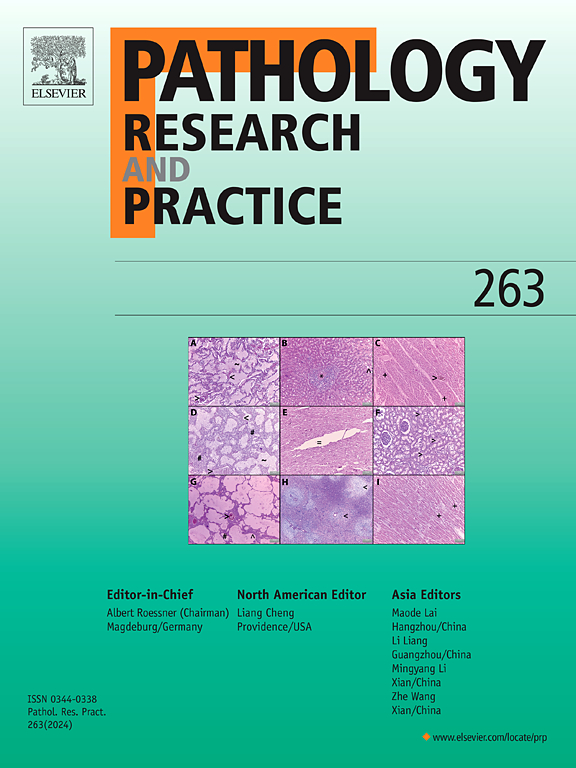Long non-coding RNAs as the pivotal regulators of epithelial mesenchymal transition through WNT/β-catenin signaling pathway in tumor cells
IF 2.9
4区 医学
Q2 PATHOLOGY
引用次数: 0
Abstract
Tumor cell invasion is considered as one of the main therapeutic challenges in cancer patients, which leads to distant metastasis and reduced prognosis. Therefore, investigation of the factors involved in tumor cell invasion improves the therapeutic methods to reduce tumor metastasis. Epithelial-mesenchymal transition (EMT) process has a pivotal role in tumor cell invasion and metastasis, during which tumor cells gain the invasive ability by losing epithelial characteristics and acquiring mesenchymal characteristics. WNT/β-catenin signaling pathway has a key role in tumor cell invasion by regulation of EMT process. Long non-coding RNAs (lncRNAs) have also an important role in EMT process through the regulation of WNT/β-catenin pathway. Deregulation of lncRNAs is associated with tumor metastasis in different tumor types. Therefore, in the present review, we investigated the role of lncRNAs in EMT process and tumor cell invasion through the regulation of WNT/β-catenin pathway. It has been reported that lncRNAs mainly induced the EMT process and tumor cell invasion through the activation of WNT/β-catenin pathway. LncRNAs that regulate the WNT/β-catenin mediated EMT process can be introduced as the prognostic markers as well as suitable therapeutic targets to reduce the tumor metastasis in cancer patients.
长非编码 RNA 通过 WNT/β-catenin 信号通路成为肿瘤细胞上皮间充质转化的关键调控因子
肿瘤细胞侵袭被认为是癌症患者的主要治疗难题之一,它会导致远处转移并降低预后。因此,研究肿瘤细胞侵袭的相关因素有助于改进减少肿瘤转移的治疗方法。上皮-间质转化(EMT)过程在肿瘤细胞侵袭和转移中起着关键作用,在这一过程中,肿瘤细胞通过失去上皮特征和获得间质特征而获得侵袭能力。WNT/β-catenin 信号通路通过调控 EMT 过程在肿瘤细胞侵袭中起着关键作用。长非编码 RNA(lncRNA)也通过调控 WNT/β-catenin 通路在 EMT 过程中发挥重要作用。在不同类型的肿瘤中,lncRNAs 的失调与肿瘤转移有关。因此,在本综述中,我们研究了lncRNAs通过调控WNT/β-catenin通路在EMT过程和肿瘤细胞侵袭中的作用。据报道,lncRNAs主要通过激活WNT/β-catenin通路诱导EMT过程和肿瘤细胞侵袭。调控WNT/β-catenin介导的EMT过程的LncRNAs可作为预后标志物和合适的治疗靶点,以减少肿瘤患者的肿瘤转移。
本文章由计算机程序翻译,如有差异,请以英文原文为准。
求助全文
约1分钟内获得全文
求助全文
来源期刊
CiteScore
5.00
自引率
3.60%
发文量
405
审稿时长
24 days
期刊介绍:
Pathology, Research and Practice provides accessible coverage of the most recent developments across the entire field of pathology: Reviews focus on recent progress in pathology, while Comments look at interesting current problems and at hypotheses for future developments in pathology. Original Papers present novel findings on all aspects of general, anatomic and molecular pathology. Rapid Communications inform readers on preliminary findings that may be relevant for further studies and need to be communicated quickly. Teaching Cases look at new aspects or special diagnostic problems of diseases and at case reports relevant for the pathologist''s practice.

 求助内容:
求助内容: 应助结果提醒方式:
应助结果提醒方式:


